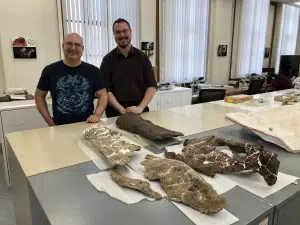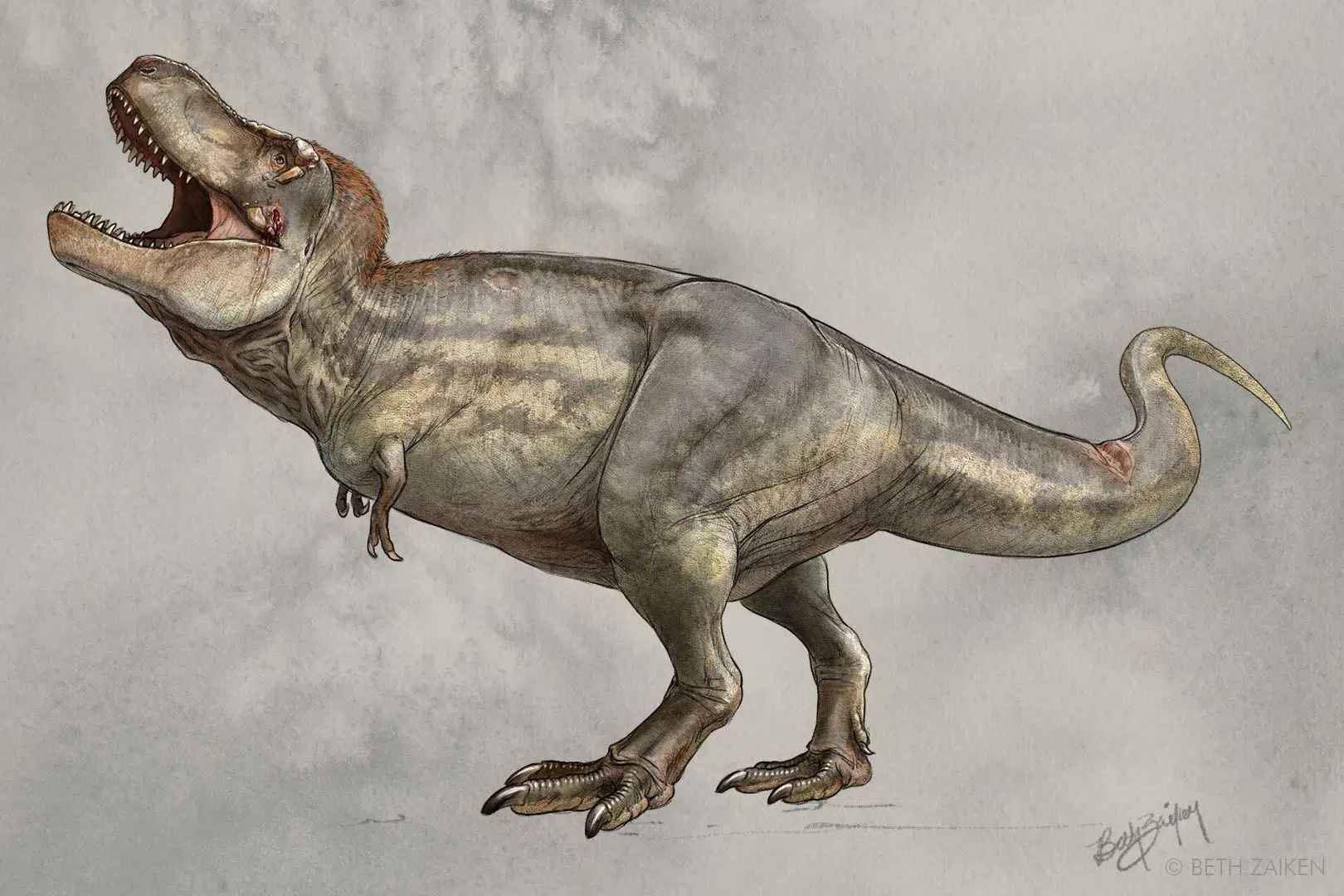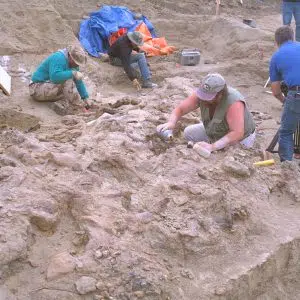The biggest Tyrannosaurus rex ever discovered will stand tall for the first time in Regina next month.
Scotty is coming to the Royal Saskatchewan Museum (RSM) following decades of fossil excavation, preparation and study by paleontologists.
This T. rex roamed Saskatchewan approximately 66 million years ago in the Cretaceous period, weighing an estimated 19,400 pounds (8,800kg) and stretching as long as a school bus. Scotty was discovered in the Frenchman River Valley near Eastend in 1991 between the release of the Jurassic Park novel (1990) and the Steven Spielberg movie (1993).
Ryan McKellar is the curator of invertebrate paleontology at the museum. While he said the size of the movie dinosaur seems to fluctuate from film to film, McKellar believes Scotty is fairly comparable to the Jurassic Park T. rex.
“We’re talking about a full-grown adult and it’s huge,” said McKellar.

Wes Long (L) and Ryan McKellar (R) standing by T.rex bones in the paleo lab in Regina. (Andrew Shepherd/980 CJME)
Scotty was first put on display at the T. rex Discovery Centre in Eastend in 2015. While that exhibit focuses on the dinosaur’s discovery and what it means to paleontology in the area, the Regina exhibit will focus on Scotty’s habitat, how it lived and its hidden features.
Since the Jurassic Park movie, scientists have learned much more about feathers on dinosaur, which are the ancient ancestors to today’s birds.
“We understand that feathering goes much, much deeper into the evolutionary tree of dinosaurs and even tyrannosaurs would have had some feathering,” said McKellar.
The 30 years that Scotty lived were a rough three decades, maybe just as violent as in the movies. Similar to how some of today’s animals compete within species for mates or property, T. rexes used to fight each other too.
Visitors will be able to get a closeup look at, and in some cases touch, some of the injuries that tell the story of Scotty’s life.
“These include things like big, open wounds on the face that have pierced all the way through to sinus cavities in the skull, holes in the jaw that are probably related to other tyrannosaurs biting the face, (and) a big wound in the tail that may have been a long-term deformity within the tail vertebrae that may have affected how it moved,” said McKellar.
Years of fossil preparation
In many cases, decades of careful, meticulous work are involved from the point of discovery until a dinosaur skeleton of this magnitude is revealed as a mounted specimen.
It took two major excavations to pull Scotty’s skeleton from the ground, the first in 1994-95 followed by a second excavation from 2000-03 when even more bones were found.
Wes Long started as a volunteer and was hired by the RSM in 2001. He spent a decade preparing Scotty’s bones.
The backbreaking work starts at the dig site with a track hoe removing boulders and sometimes entire hillsides, followed by jackhammers to plow through an iron stone layer. The tools get smaller and smaller as searchers get closer to the bone layer, using shovels, air guns, chisels and brushes. Once the bone is uncovered, it’s surrounded in a plaster jacket in order to safely move the fossil to the lab.
More hand tools are used in the lab to carefully free the bones from the rock that Scotty was entombed in for millions of years.
“A lot of Scotty’s bones were in fairly poor condition so you’re constantly stabilizing with glue,” said Long.
The mentally exhausting process is time-consuming and requires a lot of focus. Long said it took him four months just to prepare the maxilla bone known as the upper jaw.
“This is going to sound weird. You have to be able to see into the rock,” said Long. “It’s like, ‘OK, if I keep following it this way, (the bone) should be there.’ ”
Long has a background in art, which he said comes in handy while laying the bones out on the table, putting them all together like a puzzle with missing pieces.
Scotty is 65-per-cent complete, which is good for a T. rex, but it’s missing its front limbs (arms), tips of its hind limbs (feet) and some elements of the vertebrae.
The original bones are much too fragile, brittle and incredibly heavy to put on display as a standing skeleton. Instead, a replica of Scotty is made with fibreglass casts, then mounted on a steel frame. Some of the smaller-scale molding and casting is done in house while the bigger pieces are made by a company in Hamilton.
An artistic mind is helpful in reconstructing missing parts, comparing them to other bones in the collection to match, scaling them to size, painting to look like a real bone, 3D scanning and printing plus digital drawings of what Scotty might have looked like.
“I don’t think a lot of people realize … there is a lot of hard work that’s put in by a lot of people,” said Long.












